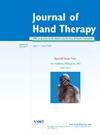术后手部治疗与 2018 年医疗保险治疗上限的废除:评估成本和使用变化。
IF 2.1
4区 医学
Q2 ORTHOPEDICS
引用次数: 0
摘要
背景:腕管松解术 (CTR)、扳机指松解术、神经节囊肿切除术、De Quervain 腱鞘炎松解术、腕掌关节成形术以及桡骨远端骨折、切开复位内固定术或经皮穿刺固定术 (DRF) 后,治疗的使用非常普遍。目的:本研究旨在评估废除长期存在的医疗保险年度门诊治疗上限后,按种族和手术方式划分的手部术后治疗费用和使用情况的变化:研究设计:回顾性队列研究:这是一项纵向回顾性队列研究,采用准实验性中断时间序列设计,包括2016年1月1日至2019年12月31日期间接受普通手部手术的患者:该研究共纳入 203 672 名患者,平均年龄为 71.4 岁。在政策实施前,白人(1.00,95% 置信区间[CI]:0.999-1.007,p = 0.45)和非白人(1.00,95% 置信区间:1.00-1.01,p = 0.06)患者的治疗使用每月均无变化。在 CTR 实施后,治疗频率增加了(几率比 [OR] 1.12,95% CI:1.11-1.14,P 结论:本研究发现,在某些子集(包括 CTR 和 DRF)中,承保范围的扩大与术后治疗使用的增加有关,这表明有必要通过事先授权或捆绑支付等方式优化承保范围,而不仅仅是增加承保福利。本文章由计算机程序翻译,如有差异,请以英文原文为准。
Postoperative hand therapy and the 2018 Medicare therapy cap repeal: Appraising cost and use changes
Background
Therapy use is common following carpal tunnel release (CTR), trigger finger release, ganglion cyst excision, De Quervain tenosynovitis release, carpometacarpal arthroplasty, and distal radius fracture, open reduction internal fixation or percutaneous pinning (DRF). Policy that improves coverage influences the cost and use of health care services.
Purpose
This study aims to evaluate changes to the cost and use of postoperative hand therapy by race and procedure following the repeal of a longstanding annual Medicare outpatient therapy cap.
Study Design
Retrospective cohort study.
Methods
This is a longitudinal retrospective cohort study using a quasi-experimental interrupted time series design, including patients who underwent common hand surgeries from January 1, 2016-December 31, 2019.
Results
This study included 203,672 patients with a mean age of 71.4 years. Neither White (1.00, 95% confidence interval [CI]: 0.999-1.007, p = 0.45) nor non-White (1.00, 95% CI: 1.00-1.01, p = 0.06) patients experienced monthly changes in therapy use before policy implementation. Therapy frequency increased following CTR (odds ratio [OR] 1.12, 95% CI: 1.11-1.14, p < 0.001), trigger finger release (OR 1.09, 95% CI: 1.07-1.10, p < 0.001), and DRF (OR 1.05, 95% CI: 1.03-1.06, p < 0.001) following implementation.
Conclusions
This study found that improved coverage was associated with increased postoperative therapy use among some subsets, including CTR and DRF, suggesting the need to optimize coverage by means such as prior authorization or bundled payments, rather than only increasing coverage benefits.
求助全文
通过发布文献求助,成功后即可免费获取论文全文。
去求助
来源期刊

Journal of Hand Therapy
医学-外科
CiteScore
3.50
自引率
10.00%
发文量
65
审稿时长
19.2 weeks
期刊介绍:
The Journal of Hand Therapy is designed for hand therapists, occupational and physical therapists, and other hand specialists involved in the rehabilitation of disabling hand problems. The Journal functions as a source of education and information by publishing scientific and clinical articles. Regular features include original reports, clinical reviews, case studies, editorials, and book reviews.
 求助内容:
求助内容: 应助结果提醒方式:
应助结果提醒方式:


